Overview
Snakes are reptiles in the Linnaean taxonomy that include over 3,600 species distributed on every continent besides Antartica. The United States is home to about 50 species of snakes with 47 of those species being found in Missouri. Most of the snakes in Missouri are also found in varying concentrations in the surrounding states but some stretch to areas even further away. All five of Missouri’s venomous snakes are pit vipers, meaning they all have a deep pit between the eye and nostril on both sides of the head. These pits serve as infrared-detecting organs, allowing them to detect prey. Pit vipers can also be distinguished by their vertical pupil shape. Snakes reproduce sexually and approximately half of Missouri’s snakes lay eggs, rather than giving birth to live young. Egg-laying species give birth to young that develop a special egg tooth that grows at the tip of its face. This tooth is used to break through the shell of the egg and is later shed. Only about 725 species of snakes in total are venomous, and most do not attack humans but use their fatal bite to feed on prey sich as rodents, reptiles, birds, fish, or other smaller animals.
Snake Movement
Depending on the species, snakes can have 200-400 vertebrae. Because of this, they have the flexibility to move forward using a fluid side-to-side motion. They can also travel sideways in a motion called sidewinding. This is typically used on slippery surfaces like sand or mud. When sidewinding, a snake will contract its muscles to hurl its body through the air, moving laterally and maintaining only two points of contact with the ground. There are three other methods that snakes use to move: serpentine, caterpillar, and concertina. Most snakes use the serpentine method, which is the familiar S-shape movement that most people associate with snakes. The snake contracts its neck muscles to move its body from side-to-side. Aquatic snakes prefer this method because the water pushes back against the snake’s motion and propels it forward. On land, snakes will use resistance points such as rocks or sticks to propel themselves forward. The caterpillar method of movement is much slower, and also involves contracting muscles to create curves. However, these curves are up and down rather than lateral. The snake’s ventral scales on the bottom curves grip the ground, allowing the snake to push itself forward. The concertina method of movement is used for climbing. The snake extends its head and grips the surface with its ventral scales, forming tight curves with the middle of its body and pulling its back end up. Scales usually come in distinct patterns that aid in species identification as well as serve to warn off predators or blend in with the natural environment. The scales of a snake provide an evolutionary advantage because they protect from injury. Scales are made from keratin, the same material that makes up fingernails in humans. The layer that is shed is called the epidermis, whereas the developed layer underneath is the dermis. Snakes are able to detect low frequency sounds that aid in detecting motion and waves traveling through solid ground.
Snake Anatomy
Snake species can range in size from 4.1 inches to 17.1 feet. One of the most distincting characteristics of snakes is the shedding of snakeskin, or molting, that allows cell turnover and new growth. The anatomy of snakes’ respiratory system is interesting. Behind the snake’s tongue, they have a small opening called the glottis, which leads to the trachea. The glottis is always closed in a vertical slit, except for when the snake takes a breath. A small piece of cartilage in the glottis vibrates when the breath is expelled, which produces the snake’s hiss. While eating, the snake can extend its glottis out the side of its mouth, so that it can continue breathing while digesting large prey. The flexible jaw allows a snake to swallow its prey whole, even prey many times larger than the circumference of its body. Most snakes have a small or vestigial left lung, while the right lung is much longer and more functional. The portion of the right lung closest to the head does most of the respiration, whereas the portion closest to the tail functions more like an air sac. Strong muscles lining the body walls allow for the slow digestion of pret and the expansion of the body to allow the passage of food.
Snakes’ forked tongues allow detecting minor scents which aid in hunting. Snakes use their upper and lower teeth to grasp food, venomous snakes use their distinct fangs as well. Teeth are not necessarily used to mechanically break down food, since snakes swallow their prey whole and use the contraction of their muscles in the body to mechanically break down food instead of “chewing” as humans are used to. The pliability of snake skin and flexibility of the jaw allows for the easy passage of food through the length of the body. Once the food has moved through the stomach, it is transported to the small intestine called the duodenum. Once food has passed through the gastrointestinal system it is excreted through the cloaca. The cloaca has three main sections: the coprodeum, the urodeum, and the proctodeum. These chambers handle excretions and reproduction. 1
Snakes breathe similarly to mammals by contraction of muscles to allow the passage of air into the abdomen. The air sac of the snake located near the tail functions as an air sac but does not contract in the same way as a lung.
Classification of Snakes
Kingdom: Animalia
Phylum: Chordata
Class: Reptilia
Order: Squamata
Clade: Ophidia
Venomous Snakes
Non-Venomous Snakes
Eastern Yellow-bellied Racer (Coluber constrictor flaviventris)

Eastern Yellow-bellied Racer; David Sledge, 2009; Wikimedia Commons
Color varies—olive, brown, blue with a yellow or cream-colored underside. Young racers have brown spots that fade as they mature. Grow between 30 and 50 inches. Live in grasslands, brushy areas, prairies, fields, and open woodlands. Racers will occasionally vibrate their tails if alarmed. Diet includes frogs, lizards, rodents, and birds.
Northern Scarlet Snake (Cemohora coccinea copei)

By Glenn Bartolotti – Own work, CC BY-SA 3.0, https://commons.wikimedia.org/w/index.php?curid=26292671
Red saddles bordered by black with a large, red head and unpatterned white belly. Similar in color and pattern to the red milk snake, but has a red or orange snout with a white belly. Grows between 14 and 20 inches. Lives underground for most of its life, but goes above ground to feed on the eggs of other reptiles, rodents, lizards, and small snakes.
Prairie Ring-Necked Snake (Diadophis punctatus arnyi)

By Psyon – Own work, CC BY-SA 4.0, https://commons.wikimedia.org/w/index.php?curid=45087526
Dark coloration on the back (dark brown, grey, or blue-black) with a yellow-orange underbelly and yellow ring around the neck. The belly has small black spots. Grows between 10 and 14 inches. Typically lives in rocky, wooded hillsides and seeks shelter under rocks. Diet includes worms, slugs, insects, and small salamanders.
Western Worm Snake (Carphophis vermis)

By Peter Paplanus – Own work, CC BY-SA 4.0 https://www.flickr.com/photos/2ndpeter/33569944852
Purple-brown coloration with salmon pink underbelly and sides. The tail has a harmless spike that allows it to move through soil. Grows between 7 and 11 inches. Worm Snakes hide under rocks and logs or burrow into the soil. Lives mainly in wooded hillsides. Diet includes earthworm, insect larvae, and insect eggs.
Earthsnakes
Earthsnakes include the genera Haldea and Virginia and are found exclusively in the eastern and southeastern United States. They have a divided cloacal.
Rough Earthsnake (Haldea straitula)

By Andrew DuBois CC BY-NC 2.9 https://www.flickr.com/photos/138578145@N04/47766239751/in/photolist-nL6HHg-qDyoin-rAmPTg-22WPaib-2fLWsVM-8EriTZ/
The Rough Earthsnake is on the smaller side, ranging from 18-25 cm in length. They are found in the United States ranging from Virginia to central Texas, including parts of south and south-central Missouri. They are a light grey or brown color with a pointed head. They have keeled scales and an undivided cloacal. The young of the species are usually darker in color than the adults. The Rough Earthsnake can be found in woodlands and open areas.
Western Smooth Earthsnake (Virginia valeriae elegans)

By Andrew Hoffman CC BY-NC-ND 2.0 https://www.flickr.com/photos/71701055@N00/2689100153/in/photolist-56CkMK-3kWXxq-UB4kH
The Western Smooth Earthsnake can be found from southern Indiana down to central Texas, including much of eastern and central Missouri. They are18-25 cm in length. These snakes can range from red to greyish brown with white ventral scales. The scales are keeled.
Ratsnakes
North American and Desert Ratsnakes include the genera Pantherophis and Bogertophis. One defining characteristic of these types of snakes is that their cross section is shaped like a loaf of bread in which the flat belly meets the sides of the snake at a distinct angle. They have keeled middorsal scales and a divided cloacal. Some populations of these snakes retain dark blotches from birth, some lose the blotched pattern over time.
Western Ratsnake (Pantherophis obsoletus)

By Peter Paplanus- Own Work, CC BY 2.0 https://www.flickr.com/photos/2ndpeter/23931822917/in/photolist-CsLRbv-U2t3rJ-sDjpMt-SRpnhT-cxjrE1-ahV3Mn-sDhYMg-smJHyu-nUrrV9-nUyRpx-nC5fXT-nUgKrR-2g55enC-CPXEu3-9zZw9e-9A3uA3-2g8kxkp-fszy7M/
The Western Ratsnake can be found ranging from Iowa south to eastern Texas and Louisiana, encompassing all of Missouri. They average 107-183 cm in length. Western Ratsnakes can range from solid colors to a variety of colored patterns. Some Western Ratsnakes are solid black in color, but others can be grey, brown, or slightly yellow with black, brown, or grey blotches on the dorsal scales. The ventral scales are usually solid in color and lighter than the dorsal scales. The head is generally small and absent of pattern. They are usually found in rocky hillsides or around abandoned buildings.
Black Rat Snake (Elpahe obsoleta)

By Stephen Lody Photography – Own work http://www.behance.net/kadoka, CC BY-SA 3.0, https://commons.wikimedia.org/w/index.php?curid=25086856
Usually shiny black in color, but sometimes has dark brown blotches. Underbelly is grey and black. Grows between 42 and 72 inches. Lives in rocky, wooded hillsides, near rivers, or near farms. Able to climb trees and kills their prey through constriction. Diet includes rodents, birds, and birds’ eggs.
Great Plains Rat Snake (Elaphe guttata)
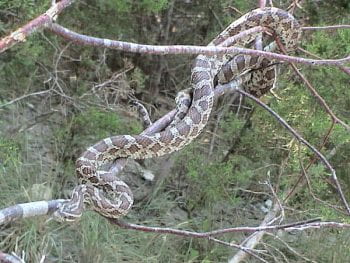
By Dawson at English Wikipedia. – Own work, CC BY-SA 2.5, https://commons.wikimedia.org/w/index.php?curid=26070126
The Great Plains Rat Snake has brown blotches and distinctive facial markings. It grows between 24 and 36 inches long. Great Plains Rat Snakes live in the wooded areas in the southern half of Missouri and along the Missouri River. Their diet consists of rodents, bats, and birds.
Western Mud Snake (common name: hoop snake) (Farancia abacura reinwardtii)

By John Sullivan – Own work, CC BY-SA 3.0, https://commons.wikimedia.org/w/index.php?curid=21703177
This snake has a shiny black back with a red, pink, and orange belly. Its tail ends in a sharp point. Western Mud Snakes will grown between 40-54 inches. They live in the southeastern swamps of Missouri. Mud snakes eat three-toed amphiuma, a type of aquatic salamander; tadpoles; and fish.
Western Fox Snake (Elaphe vulpina)
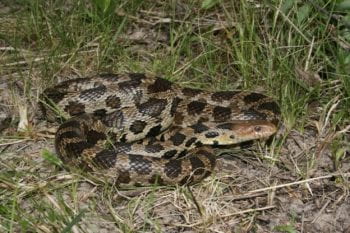
By Don Becker – Own work, CC BY-SA 3.0, https://commons.wikimedia.org/w/index.php?curid=24507539
The Western Fox Snake is yellow, green-brown, or tan with brown blotches and some orange coloring on its head. Its belly is yellow with a black checkered pattern. This snake grows between 36-54 inches. This snake is not very common in Missouri, but it has been found in the Northern third of the state in marshes. Their diet consists of small rodents and birds.
Plains Hog-nosed Snake (Heterodon nasicus nasicus)

By Peter Paplanus – Own work, CC BY-SA 4.0 https://www.flickr.com/photos/2ndpeter/27232938000
This snake is tan or grey with dark brown or grey blotches. Females have more blotches than males. These snakes differ from Eastern Hog-nosed Snakes because of their snouts, which are upturned, and the black coloration on the underside of their tails. They grown between 16 and 25 inches and are very rare in Missouri. They live in loose, sandy soil in prairies and feed on toads, snakes, lizard eggs, and small rodents. They use their upturned snouts to dig for their prey.
Eastern Hog-nosed Snake (Heterodon platirhinos)
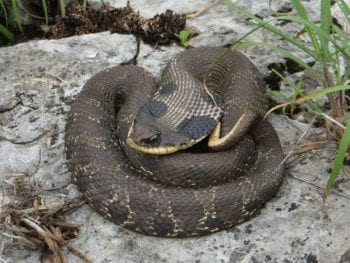
By Psyon – Own work, CC BY-SA 4.0, https://commons.wikimedia.org/w/index.php?curid=45087640
The Eastern Hog-nosed Snake is grey-brown with dark brown markings on its back and a grey belly. It grows between 20-33 inches and lives in sandy areas or open woods. Its diet consists mainly of toads, but it also eats frogs and salamanders. This snake is harmless, but can hiss loudly and spread its neck like a cobra. It will also play dead in self defense.
Kingsnakes and Milksnakes
Both part of the genus Lampropeltis, Kingsnakes and Milksnakes have a large geographical range in North America, ranging from Canada to Montana to Ecuador. These snakes have smooth scales and an undivided cloacal.
Prairie Kingsnake (Lampopeltis calligaster calligaster)
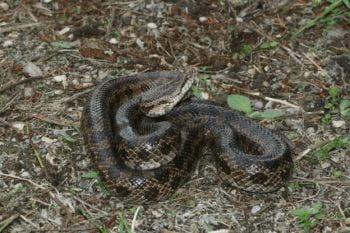
By Don Becker – Own work, CC BY-SA 3.0, https://commons.wikimedia.org/w/index.php?curid=32700947
This common snake is tan, brown-grey, or green-grey with dark blotches on its back and sides and a yellow-tan belly with dark markings. It grows between 30 and 42 inches. Its habitat is found in prairies, woodlands, and rocky hillsides. Kingsnakes can eat other snakes, including venomous species. They are immune to the venom of copperheads, cottonmouths, and rattlesnakes. They also eat lizards, rodents, and birds.
Speckled Kingsnake (Lampropeltis getula holbrooki)

By Peter Paplanus – Own work, CC BY-SA 4.0 https://www.flickr.com/photos/2ndpeter/26289894531
The Speckled Kingsnake is black with a white or yellow spot on most scales. Because it looks speckled, it is commonly referred to as the salt and pepper snake. This snake grows between 36 and 48 inches. It lives under rocks and logs in rocky, wooded hillsides. It eats lizards, other snakes, and small rodents.
Red Milk Snake (Lampropeltis triangulum syspila)

By The original uploader was BillC at English Wikipedia. – Transferred from en.wikipedia to Commons., CC BY-SA 3.0, https://commons.wikimedia.org/w/index.php?curid=2663201
The Red Milk Snake is white with red or orange markings with black borders. Its belly is white with a black checkered pattern. These snakes grown between 21 and 28 inches. They are found statewide in Missouri and live in wooded, rocky hillsides and cedar glades. Its diet consists of lizards, small snakes, and mice.
Western Milksnake (Lampropeltis gentilis)
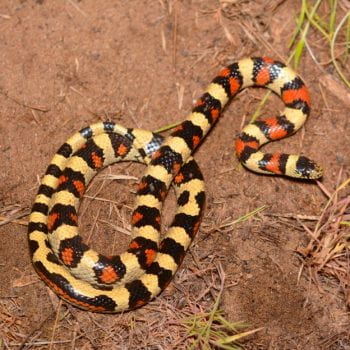
By Andrew DuBois- Own work, CC BY-NC 2.0 https://www.flickr.com/photos/138578145@N04/27252333406/in/photostream/
The Western Milksnake can be found on the western border of Missouri, across the Rocky Mountains, and reaching all the way north to Montana. They average 41-76 cm in length. The Western Milksnake is white or cream color with black-edged red or orange rings found on the unkeeled (smooth) dorsal scales. The ventral scales are white or cream colored with scattered black checks. The head is generally black. Their habitats are varied but many have been found in grasslands and rocky soils.
Eastern Milksnake (Lampropeltis triangulum)
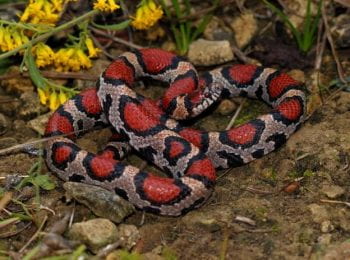
By Peter Paplanus- Own Work, CC BY 2.0 https://www.flickr.com/photos/2ndpeter/48848367298/in/photolist-2hqyDKh-27YyCKJ-YJ38sn-cETfDm-2g72rEn-24Z1HQ7-67iYxf-utJK8m-rJDP3e-Z6hF6E-ihLjKP-6LTRCe-J7PsFF-p5hnUn-ekEbk9-8Aunmd-26BC7U9-6VmVCv-4JgX52-6yjiXF-aeRUEL-4JmaM5-6Vm1zg-eJsorU-56GuKC-sJWHMP-oqqNu-nFLUuD-7u1KMR
The Eastern Milksnake can be found ranging from southeast Canada and New England across the entire state of Missouri and reaching south to Louisiana and Alabama. They range in size from 61-90 cm. The Eastern Milksnake can range in color including grey, tan, or cream with large black-edged brown middorsal blotches extending down the sides of the snake. The blotches do not extend to the ventral scales. The head has a distinct V shape that connects to the pattern on the rest of the body. Its habitat includes woodlands, rocky hills, and riverbeds.
Eastern Coachwhip (Mazticophis flagellum flagellum)
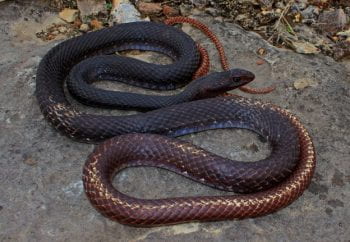
By Peter Paplanus – https://www.flickr.com/photos/2ndpeter/36423893164/in/dateposted/, CC BY 2.0, https://commons.wikimedia.org/w/index.php?curid=62662759
The Eastern Coachwhip is dark brown on its front half with a tan body and belly. They grow to be very long, averaging 42-60 inches. Eastern Coachwhips live in rocky, wooded hillsides and prairies. Their diet consists of mice, insects, lizards, snakes, and birds. They are found in the southern half of Missouri.
Rough Green Snake (Opheodrys aestivus aestivus)

By Asklēpiós – Own work, CC BY-SA 4.0, https://commons.wikimedia.org/w/index.php?curid=59548211
This snake is light green with a white belly. It is long and thin with keeled scales. It is 22 to 32 inches in length. Rough Green Snakes live in bushes, vines, or low-hanging branches near bodies of water. It eats soft-bodied insects like grasshoppers and crickets and is found in the southern half of Missouri.
Smooth Green Snake (Opheodrys vernalis)

By Don Becker – Own work, CC BY-SA 4.0, https://commons.wikimedia.org/w/index.php?curid=40879938
This snake appears very similar to the Rough Green Snake, but it has smooth scales instead of keeled scales. It is also smaller than the Rough Green Snake, averaging 14-20 inches in length. It lives in grassy meadows in northern Missouri, but is endangered due to habitat destruction.
Bullsnake (Pituophis catenifer sayı)

Public Domain, https://commons.wikimedia.org/w/index.php?curid=1529601
This snake is tan with brown or black blotches. Its belly is yellow with dark spots along the sides. It ranges in length from 37 to 72 inches. It is found primarily in prairies but has also been seen in areas near the Ozarks. It eats small mammals, birds, and birds’ eggs.
Crayfish Snakes
These snakes include species with genus Regina and can be found in eastern North America. They have generally small heads, 19 scale rows, keeled scales and a divided cloacal.
Graham’s Crayfish Snake (Regina grahamii)

By Jeromi Hefner – Flickr: Graham’s Crawfish Snake (Regina grahamii), CC BY 2.0, https://commons.wikimedia.org/w/index.php?curid=29704043
The Graham’s Crayfish Snake can be found from northern Illinois to southeastern Texas, including many parts of northern Missouri. They are 46-71 cm in length. They are distinct in color with black or dark brown dorsal scales and a light-yellow belly, almost looking like an individual was split in half. There are narrow black stripes where the dorsal scales meet the ventral scales on the sides of the snake. There also may be a pale middorsal stripe running the length of the individual. This snake is very reclusive, taking shelter under rocks or logs in marshes or along streams. Its diet consists mainly of crayfish, and it spends the winter in crayfish burrows.

By Peter Paplanus CC BY 2.0 https://www.flickr.com/photos/2ndpeter/32533152744/in/photolist-2g5QFpA-RyQUSC-rrPbxh-uhSNX1-veSW2T-uXiF9m-vcyPtw-s6Seqf-rRA5jQ-FJKdET-GyhkoX-2hzvq2w-2hzup83-2hzrC6f-FWbRaK-uXreRc-vczn95-67eKeK-uXicHS-uXhPJG-vcyRnm-FJKbev-CQ1fbC-ui3kCk-ui3p36
Ground Snake (Sonora semiannulata)
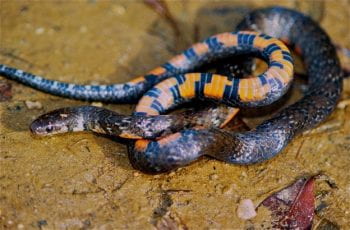
By Bernard DUPONT from FRANCE – Short Ground Snake (Liophis breviceps), CC BY-SA 2.0, https://commons.wikimedia.org/w/index.php?curid=40775224
This snake varies in color. It ranges from grey or brown to orange and red with dark bands. Its belly is white or cream with dark bands around its tail. It is small, only growing between 8 and 12 inches. Ground Snakes live in rocky glades and woodlands, where they live under flat rocks. They eat scorpions, centipedes, and spiders. Ground Snakes are found in the southwestern corner of Missouri.
Flat-headed Snake (Tantilla gracilus)
This snake is tan, brown, or reddish-brown with a dark head and a pinkish belly. It is the smallest snake in Missouri, growing between 7 and 8 inches. It lives under rocks in moist soil, typically on wooded hillsides. It eats centipedes and insect larvae and is found in most of the southern half of Missouri.
Gartersnakes and Ribbonsnakes
Species of Gartersnakes and Ribbonsnakes are found in the genus Thamnophis and can physically be found from southern Canada to Costa Rica. They have keeled scales and an undivided cloacal. Most species have yellow longitudinal stripes.
Plains Garter Snake (Thamnophis radix)
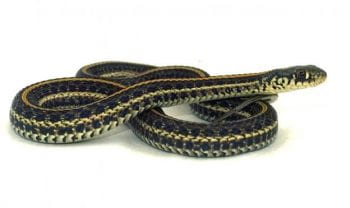
By Thamnophis – Own work, CC BY-SA 3.0, https://commons.wikimedia.org/w/index.php?curid=6377326
This snake has a yellow strip down its back with black spots and bars on its back. It is 15-28 inches long and lives in meadows, prairies, marshes, and near lakes and ponds. Its diet consists of worms, amphibians, and minnows.
Eastern Garter Snake (Thamnophis sirtalis sirtalis)

By D. Gordon E. Robertson – Own work, CC BY-SA 3.0, https://commons.wikimedia.org/w/index.php?curid=6516547
This common snake ranges in color from dark brown to olive green. It has three yellow stripes and yellow belly. It ranges in length from 18 to 26 inches. This snake is found in a wide variety of habitats across eastern Missouri.
Red-sided Gartersnake (Thamnophis sirtalis parietalis)

By Andrew DuBois CC BY-NC 2.0 https://www.flickr.com/photos/138578145@N04/30570034633/in/photolist-NRtbsv-NzjMce-NznqfD-PzY1NE-SBMjqa-TE6FtK-ahSo64-ahSnTX-9t2YGt-9XwkmX-an8b8y-dL7JLN-9pXLZQ-9pWjL7-ap3wTd-ecU7d1-9pRKWK-9pUMWd-9pXLXU-9pUKD2-9t5YqA-9pTi8H-9t2NRZ-TXLXVx-7RurZi-84aZgy-847Ubp-cNaadW-bsyvpN-eHo9nr-eHo9bD-BzJYec-S9xwP1-RCuVBL-Sd8PEt-StTPxz-RYxhCS-RCuSYE-bsyyzE-bsywAd-5H4Ww-bFtqsB-6tXziX-Sd9fJM-QYbeBH-QYaNfF-bsyuVU-RYxM6d-Sd9s5H-eHo97p/
The Red-Sided Gartersnake can be found from central Canada to Oklahoma, including the northwest corner of Missouri. It is 46-66 cm in length. This species is black, brown, or olive in color with distinct red or orange bars on the sides. In addition to these red markings, a lighter middorsal and lateral stripes run down the length of the body. The ventral scales are lighter but can have a few dark spots. They can be found in a large variety of habitats including meadows, marches, alongside streams, and even in more residential or developed city areas.
Western Ribbon Snake (Thamnophis proximus)
This snake has a greenish belly with black and yellow stripes down its back. It ranges in length from 20 to 30 inches. The Plains Garter Snake lives in wooded areas near water, feeding on small frogs and minnows. Like all garter snakes, this snake will emit a strong-smelling musk from the cloaca glands at the base of the tail.
Orange Striped Ribbonsnake (Thamnophis Proximus Proximus)

By Douglas Mills CC BY-NC-ND 2.0 https://www.flickr.com/photos/dmills727/186928351/in/photolist-hw4hB-hw4qn-DsRJLZ-bAVPH3-c1tezo-sNRAf5-nwEE8M-nNRzwP-9oJhJp-nwEE6T-51YLED-Uj5Gw-TYTsT-2vpWZj-22WPEpC-21USN4b-5Riqq2-9Emy1u-YRmfZ1-8MmQUx-CHGYh-RPHdDt-8RNB1Z-CHGYg-8Cxf1P-8Cxffe-UATjp-4sCFhL-aBLYhm-CHGYj-CHGYm-tXEp6-CyTUf-4SszT7-ZrZCPN-9Emybu-Fmjqt-o5mcJC-a2Sajv-6ezrvc-6yoDm1-7PfYUX-J98nX7-HRTv8-21RR6R-nPV2bi-o76fMK-nPUik5-nPUjby-nPUgfV/
The Orange-Striped Ribbonsnake can be found from Iowa to Louisiana and eastern Texas, including most parts of Missouri. They range from 51-76 cm in length with a very slender body. They have three very distinct yellow or orange colored stripes running down the length of the black body. They are found in very moist environments such as streams, ditches, or lakes.
North American Brownsnakes
Species of North American Brownsnakes include genus Storeria and can be found across North and Central American from Canada to Honduras. Their scales are keeled, cloacal divided and absent loreals.
Dekay’s Brownsnake (Storeria dekayi)

By Douglas Mills CC BY-NC-ND 2.0 https://www.flickr.com/photos/dmills727/25699001033/in/photolist-gEWMoT-gEWe3x-4dBRF-4Zj6zT-F9W6EH-6Vq6v9-Q2kVgs-9xHme8-X2Yms1-2dZe33V-4Zj6gk-y2pKx7-hw4gF-4Zojew-2fiudQC-FW2FX9-sR7jFX-cPFsLo-2hwAMep-2hwx2bB-2hwzJa4-29aFoNB-24GrzXL-24GrzW3-LJUjNg
This species of Brownsnake can be found in all states east of the Great Plains, including many parts of southeastern Canada. They can be found across the entire state of Missouri. They range in size from 23-33 cm. This species of Brownsnake can be a light-yellow brown, grey, dark brown, or reddish brown. They have dark downward streaks on the dorsal scales with an unmarked pale yellow or pink belly. They can be found in moist environments including swamps, marshes, parks, or beneath trash.
Northern Red-Bellied Snake (Storeria occipitomaculata occipitomaculata)

By Andrew Hoffman CC BY-NC-ND 2.0 https://www.flickr.com/photos/71701055@N00/2773269588/in/photolist-6vkQoQ-5e4JqU-r3yjRt-zPEgmz-5dZo9R-pHDoTm-pzrhmU-pip9Uv-WGHwWQ-29f1DuD-psNakn-6pRLsA-5dZnVi-pzTdZW-JaHDvY-pzTcW3-haReyE-k1XhUJ-k1W6ac-zgmu1z-k1W4SU-haQPie-haQX32-haSyLT-oimjfs-nXSJJJ-ozNZ9q-k1V91e-k1X5t1-k1Wtnu-k1WFxG-k1V2ii-k1U9Qn-k1VvpC-k1TX8e-k1WgqJ-ozQQnX-k1VceR-3xSLiu
The Northern Red-Bellied Snake can be found from the eastern coast of Canada southwest to the eastern edge of Oklahoma, including much of central Missouri. They are 20-25 cm in length. This species has brown dorsal scales and a red belly. This species has well defined nape spots and black areas on the side scales and head. Its habit includes open woods and bogs.
Lined Snake (Tropidoclonion lineatum)

By Andrew DuBois CC BY-NC 2.0 https://www.flickr.com/photos/138578145@N04/31442683641/in/photolist-PUtYpc-HWPyVt-NRchrM-HN5Nbs-HN5Maj-HWPEyc-H1Yq8y-WoewAE-G2UV3E-egGMHT-dKVbtx-hsbp9-2c4JQs8-2bZkWvS-bTzvtB-bTzvoi-67eKgR-FYmnFZ-bDswXb-53vSQX-73sG4S-bxDAru-vtYLCm-mbdxqW-5boKsF-o55ZGd-96Cvz8-2fz5N8k-HQr1Kx-KMJaJM-2e9kgEZ-H24RPH-HwoibG-nPoKjr-9c3sMW-2e3qVVi-2g3FVgG-bxDwzu-3qpZRE-ao8fkU-4nzWkJ-8nyK59-a4FFdH-xtjfD-2eepQ7e-Tu2Cib-2fCkrfR-2fCkr3r-2fCkqEx-RRTQyT
The Lined Snake can be found sporadically around parts of Missouri, the Great Plains, Texas, and New Mexico. It is 23-38 cm in length. The species is grey or tan with a whitish or yellow middorsal stripe and two lateral stripes. It has keeled scales and an undivided cloacal. They are found in open areas like prairies or parks.
Water Snakes
Water snakes are non-venomous and live near bodies of water. They primarily eat fish and amphibians, but can also eat small reptiles and rodents. Water snakes are viviparous, meaning they give birth to live young. As a self defense mechanism, water snakes will emit a strong-smelling musk from the cloaca glands at the base of the tail.
North American Watersnakes
North American Watersnakes are the genus Nerodia and can be found in the eastern and central United States. All species have keeled scales and bear live young. They have a divided cloacal.
Plain Bellied Watersnake (Nerodia erythrogaster)
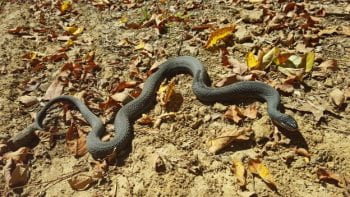
By Andrew DuBois CC-BY-NC 2.0 https://www.flickr.com/photos/138578145@N04/31539155335/in/photolist-24r4YKS-Q41q5g-QcjqLy-P21upB-Qfz8L2-Qfz9e6-QfzaW4-P21veT-Qcjqiu-Qcjssu-P21vGr-P21w6T-4st6d3-hw4rj-2hzrBZo-2hzup2G-6efYKS-hw4vX-2bU4aoH-MscJBF-21hiXzQ-R6Zh3c-i5bBPk-oyQKQ1-nyxP2h-2dbedqj-maaqbh-maamfm-afXhrC-ma9sLt-maanv7-2h61DLm-ma8Md2-ma8KxP-2h5Y77j-2h5ZTFg-2h5Y7et-2h61DqX-2h61Ed8-2h5Y7XN-2h61E4W-2h61DYk-oyQKJ9-c8qdaA-c8qd3U-8CAmPf-ejaWVh-nyxNYS-ejaWUo-97gDfk
The Plain Bellied Watersnake can be found ranging as east as Delaware and North Carolina to the southwestern parts of Texas, including parts of southeastern Missouri. They are 76-122 cm long. This species can be unicolor, slightly patterned, or have a very distinct pattern. Unicolored individuals can be brown, reddish, or grey. Patterned individuals usually have dark bordered light bands across the dorsal scales retained from youth. The ventral scales are uncolored and lighter than dorsal scales. The Plain Bellied Watersnake can be found in larger bodies of water such as rivers, lakes, or swamps.
Midland Watersnake (Nerodia sipedon pleuralis)

By Peter Paplanus CC BY 2.0 https://www.flickr.com/photos/2ndpeter/27656451262/in/photolist-wufwu5-J8UxqA-QUMANE-4VFDD1-c2zcBA-c2zbGJ-c2zbZy-c2zbbf-4KBtCw-aSQbTx-aSQbL4-9S2tpE-EBWxw-56GuMb-4KBtFS-UAThx-7ZVaet-cHn6JN-9Y1Adf-9XXG3n-9Y1AeS-9XXG1P-QBTiZ-9XXG5v
The Midland Watersnake can be found from Oklahoma to the panhandle of Florida, including the southeastern half of Missouri. It is 56-107 cm in length. This species is grey to dark brown with 30 or fewer brown or black dorsal bands with tail markings shaped as rings. It can be found in any body of water, including fast moving streams.
Mississippi Green Water Snake (Nerodia cyclopian)
Greenish-brown with brown markings. Its belly is dark grey with yellow markings. It grows between 30-45 inches. The Mississippi Green Water Snake lives in cypress swamps, and is now endangered in Missouri.
Yellow-bellied Water Snake (Nerodia erythogaster flavigaster)
This snake is greenish-grey with a yellow belly. It grows between 30 and 48 inches. This snake is found in southeastern Missouri and in the northern Mississippi River floodplain.
Broad-banded Water Snake (Nerodia fasciata confluens)
This snake is yellow and grey with large brown or black bands. It grows between 22 and 36 inches. They live in the southeastern corner of Missouri.
Diamond-backed Water Snake (Nerodia rhombifer rhombifer)
The Diamond-back is light brown with dark brown diamond-shaped markings on its sides and back and a yellow belly. They grow between 30 and 48 inches in length. This snake is found in southeastern, northern, and western Missouri, but is not found in the Ozarks.
Northern Water Snake (Nerodia sipedon sipedon)
This snake is grey or reddish brown with dark brown bands. Its belly is white to light yellow with black and red markings. The scales on its back are keeled, which means they have ridges down the middle rather than being smooth. This snake ranges from 24 to 42 inches in length. The Northern Water Snake and its subspecies, the Midland Water Snake, is found throughout all of Missouri.
Works Cited:
1Mader, Douglas. “Snake Gastrointestinal Tract Anatomy.” Reptiles Magazine.
Powell, Robert, et al. Peterson Field Guide to Reptiles and Amphibians of Eastern and Central North America. Houghton Mifflin Harcourt, 2016.
Briggler, Jeff, and Tom R Johnson. Snakes of Missouri. Missouri Department of Conservation, agrilifecdn.tamu.edu/fisheries/files/2013/10/Snakes-of-Missouri.pdf.
Montana Natural Heritage Program. “MTNHP.” Western Milksnake, 13 Nov. 2019.